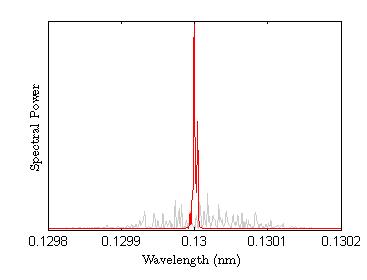ASTeC researchers have been developing a new technique which they first proposed in 2010 to dramatically improve the output quality of X-Ray Free-Electron Lasers (FELs). The technique should make the X-ray pulses more reproducible and provide users with many more photons in the very narrow wavelength bands relevant to their experiments. In effect the useful ‘brightness’of the FEL can be greatly enhanced. The work has been done in collaboration with the University of Strathclyde and was recently published in Physical Review Letters.
X-ray Free-Electron Lasers FELs (such as the LCLS at SLAC in California, SACLA at SPring-8 in Japan) use high energy electron bunches, produced by particle accelerators, to generate intense pulses of X-rays. While these FELs are currently opening up many new frontiers across science their full potential is still limited by the chaotically noisy time structure and wavelength composition of the pulses of X-rays they produce. What is really needed for a number of applications are reproducible pulses where each X-ray photon is at almost exactly the same wavelength. Such ‘Perfect Pulses’ could open up new scientific frontiers, such as in time-resolved X-ray spectroscopy or studies of molecular and cluster fragmentation.
Although other methods do exist for generating high quality pulses from FELs these can require complex optical components or synchronisation with other lasers which limits the wavelength tuning or repetition rate of the output. The new method proposed by the ASTeC researchers and collaborators does not rely on optics or lasers and can therefore be used at any wavelength or repetition rate. The idea is to use extra magnets along the FEL to slow down the electron bunches so they slip back through the X-ray pulse and ‘smear out’ the noise. By doing this, the narrow wavelength band of the X-ray photons is reduced by a factor of over one hundred and all the pulses become smooth and reproducible . Computer simulations of the technique predict it may be possible to produce ‘near-perfect’ pulses of X-ray .
This is just one of the novel FEL concepts that could be proven in principle then further developed on a dedicated FEL test facility, such as the proposed CLARA project, an upgrade to the existing VELA Facility at Daresbury Laboratory.
Original Paper:
B. W. J. McNeil, N. R. Thompson and D. J. Dunning, “Transform-Limited X-Ray Pulse Generation from a High-Brightness Self-Amplified Spontaneous-Emission Free-Electron Laser”, Physical Review Letters110, 134802 (2013).

The two images show in grey the normal output pulse from a hard X-ray FEL. The first image shows the pulse time structure, and the second image the breakdown of power over different wavelengths. With the new technique applied the output would be as shown in red. The pulse profile has been dramatically smoothed and the range of wavelengths of the X-ray photons has been compressed into a far narrower band.
Phys. Rev. Lett. 110, 134802 (2013) (link opens in a new window)
